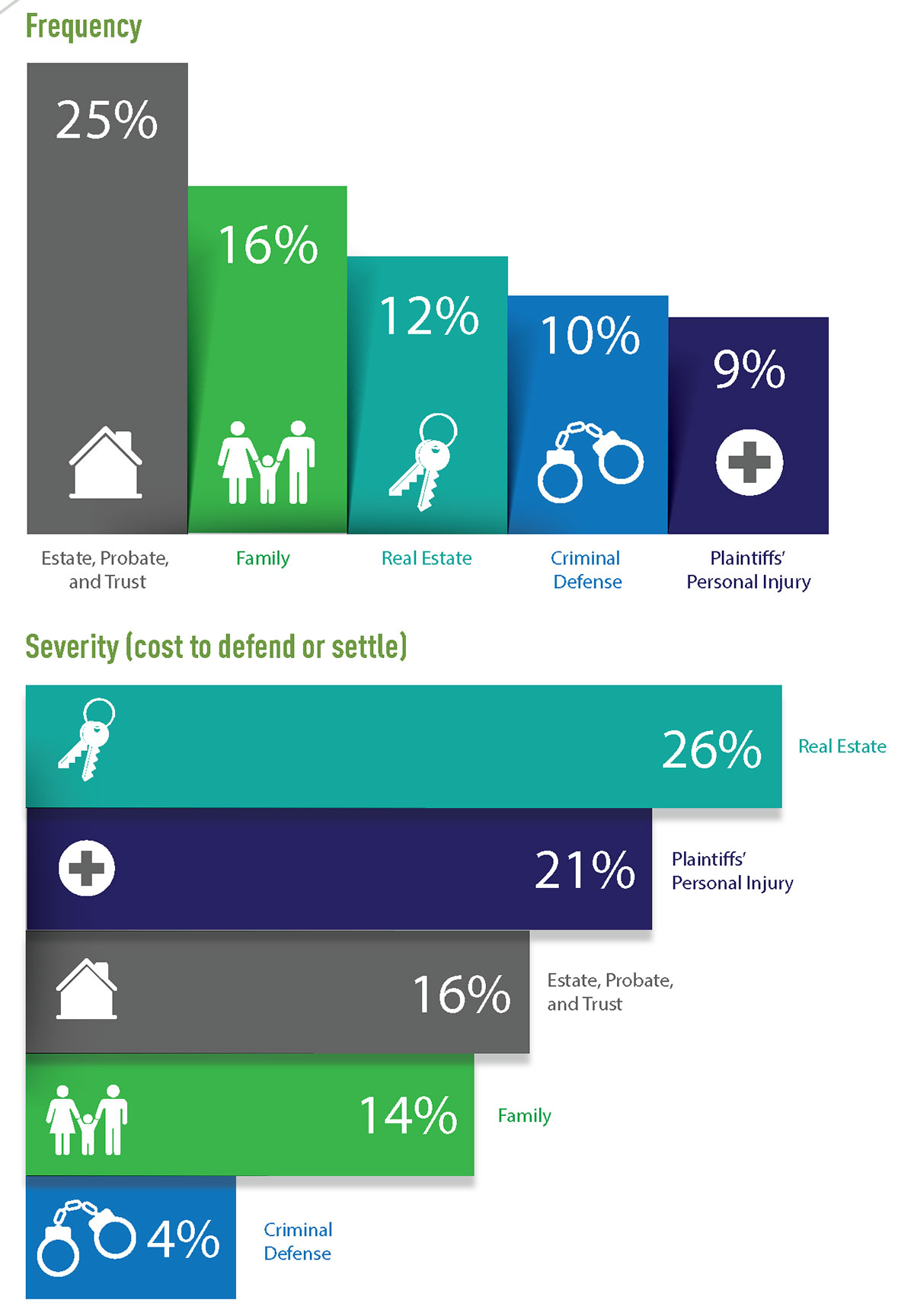
As the world marks two years since the COVID-19 pandemic hit, people are navigating 2022 thinking about how we continue to adapt. Amid the changes, lawyers must continue to think about ways to improve their practices, serve clients, and move on from the challenges of the past year.
Brian Anderson, senior claims attorney at Wisconsin Lawyers Mutual Insurance Co. (WILMIC), says that from a risk management perspective, the best way to look ahead to making improvements in your practice procedures is to look back at the prior year’s claims data, particularly which areas of practice placed lawyers at the greatest claim risk. It can also be helpful, he says, to see the types of mistakes that resulted in legal malpractice claims.
WILMIC’s 2021 Claims Data
The good news is that the number of claims reported to WILMIC in 2021 remained low, from a historical perspective. “This was the third consecutive year of below-average claims activity from a claims-frequency standpoint,” Anderson says. “As a general overview, client communication issues were the cause of most of the claims that were reported last year. The two most common error types leading to claims were the perceived failure to follow client instructions or the attorney failing to obtain the client’s consent, and failure to inform the client of the status of the matter during the course of the representation. These error types accounted for more than 40% of the claims that were reported to WILMIC last year.”
Anderson says these types of errors were at the root of most of the claims reported in 2021. “They certainly highlight the importance of clear and well- documented communication with your client at every step of the representation. A lawyer is much more likely to receive a claim when the client believes that they were not advised on the status of their legal matter or when the client believes that the attorney failed to carry out their desired course of action.”
The accompanying graphic shows the top five areas of practice that produced the most claims in 2021.
Anderson says these five areas of practice – estate, probate, and trust; family law; real estate; criminal defense; and plaintiffs’ personal injury – have historically been among the most frequent areas in which claims occur.
From a risk management perspective, it is always interesting and helpful to drill down into the areas receiving the most claims to examine what may have gone wrong to cause a claim to be pursued and consider ways to minimize the risk in those areas going forward.
The following is a deeper look at the five areas of practice that produced the most claims.
Estate Planning
Estate, probate, and trust law is the area of practice for which the most claims were received in 2021. Anderson points out, “Lawyers practicing in this area often face family disharmony, which often presents itself in ways that were not anticipated when the underlying legal services were rendered to the client. When an estate is being divided, the attorney can be scrutinized for failing to investigate all of the assets belonging to the client to make sure that they were titled in such a way as to reflect the intended distribution. When a simple will is inconsistent with a previous trust, will, transfer-on-death (TOD) bank account, or real estate deed, the attorney can end up being the target of a claim asserted by the estate or a disenfranchised beneficiary.”
Anderson notes that the added pressure of document execution during the ongoing COVID-19 pandemic also continues to result in claims associated with improperly executed or incomplete estate plans, in which the attorney is blamed for the ineffective execution. “Even if the disinherited beneficiary is not successful in this type of claim challenging the attorney’s work, the estate can look to the attorney for the costs and fees caused by having to defend against an incomplete estate plan, or the additional expenses incurred because of the lawyer’s failure to accomplish the decedent’s distribution goals, without contributing to protracted litigation,” he says.
WILMIC’s 2021 Claims Statistics by Area of Practice

Family Law
Family law is second on the list of practice areas generating the highest percentage of malpractice claims in 2021. Some of these claims focused on asset-valuation concerns that were later blamed on the attorney. Family law practitioners are at risk of claims that develop out of “post-divorce remorse” in terms of the overall division of assets. As Anderson cautions, “When there is a perceived disparity in the division of marital assets, the lawyer can be blamed for failing to adequately investigate the adverse party’s assets prior to advising the client to enter into a marital settlement agreement or finalizing the stipulated divorce. The failure to properly discover, evaluate, and advise the client on the value of the marital assets being divided has been the basis for claims in 2021, when the client later speaks with counsel to review the property division, with the full benefit of hindsight.”
WILMIC also saw claims associated with prenuptial agreements in 2021. Whenever a prenuptial agreement is struck down, the lawyers who advised the parties will be scrutinized regarding the advice provided, whether the terms of the agreement were fair, and with regard to the financial information exchanged before execution of the agreement. Anderson says that as in all types of representations, written documentation is crucial in these kinds of matters. “Because these claims may not present themselves for several years after the work was done, clear documentation between the attorney and the client regarding the scope of representation and the advice provided is essential.”
Suing a client for fees can bring its own risks, as WILMIC and many attorneys are aware. Anderson says, “In 2021, lawyers practicing family law were sometimes the subject of counterclaim legal malpractice lawsuits filed in reaction to a fee-collection action that they commenced. Getting paid for the legal services rendered is what keeps a law practice afloat; however, it comes at a risk of a fee-dispute lawsuit.”
Anderson adds that this type of claim can also present itself when an attorney moves to withdraw as counsel during the pendency of the matter. “The client will often file a claim or an OLR [Office of Lawyer Regulation] grievance against their family law counsel when they believe that they did not receive the benefit of what they paid for, or that they are being overcharged.”
Real Estate
Real estate is third on the list of practice areas producing the most claims in 2021. Real estate practice also was the most expensive area of law to insure in terms of the cost of defense and settlement payments, according to Anderson.
In analyzing these claims, Anderson says it is notable that there is often an interplay between real estate, family law, and estate planning concerns. “Although the attorney may have ‘only drafted a deed,’ when there is an action seeking to set aside the deed, concerns of undue influence, a claimed conflict of interest, or an assertion that the lawyer failed to properly advise the client regarding the transaction can be raised. A real estate practitioner might not have ever considered the overall impact the deed transaction had on an estate plan or with regard to divestment issues, leaving the lawyer vulnerable to a claim. Although a mistake contained in a deed involving the legal description of the property or an easement can often be repaired, the attorney could still face a claim for the litigation costs and fees incurred in correcting the mistake.”
Cybersecurity-related claims also remained a risk for real estate lawyers last year. “What we saw in 2021 are more sophisticated hacks into IT systems, resulting in fraudulent wiring instructions,” Anderson says. “The end result is that closing funds are wired to the wrong recipient, leading to a claim against the attorney for failing to verify the address of the recipient. Be sure you always verify wiring instructions. Trusting every email can lead to critical mistakes.”
The one risk management tip that is most likely to eliminate a claim or grievance, based on the error types reported, is clear and well documented communication with the client.
Criminal Defense
Unlike in 2020, the list of areas producing the most claims in 2021 includes criminal defense. In terms of severity, criminal defense claims have been relatively inexpensive to defend. Anderson says this disparity between the frequency of the claims reported and the severity incurred can be explained by the fact that the majority of the claims opened in this area of practice in 2021 involved OLR-grievance complaints, not true legal-malpractice-damages claims.
What mistakes arise in this area of practice? Anderson says it’s all about communication. “Communication issues between the attorney and the client make up almost all of the claim matters found in this area of practice. Criminal defense clients complain that they were not kept abreast or involved in the handling of their defense, leading to an overall high level of dissatisfaction in the handling of their criminal defense. When the client did not develop an understanding of the pros and cons of entering into a plea versus moving forward with the defense of their case, they often lash out at their counsel after sentencing.”
Plaintiffs’ Personal Injury Work
The good news is that the total number of claims against lawyers practicing plaintiffs’ personal injury law decreased. However, Anderson says this area of practice continued to be expensive to defend. “When claims were asserted against personal-injury attorneys in 2021, they ended up being costly, representing more than 20% of the overall severity experienced by WILMIC.”
What types of mistakes were made? Failing to timely file or serve a personal-injury claim within the statute of limitation was the most common error leading to claims in this area of practice, Anderson says. “Clerical calendaring errors, a misunderstanding of the facts or circumstances giving rise to the underlying action, and misunderstandings regarding the scope of retention all were factors in the claims that were asserted against lawyers in this area of practice. Once a deadline is missed governing the underlying personal-injury claim, there is often no ability to repair the potential claim matter. Careful scrutiny of the merits of the underlying claim matter are important before agreeing to handle the case, to make sure that the case is worth the time, effort, and energy of pursuing it, in light of the claims risk that accompanies this area of practice.”
Conclusion
As we move forward in 2022, lawyers who follow certain risk management strategies can once again thrive.
Overall, Anderson reports that lawyers reported fewer claims to WILMIC in 2021 than WILMIC has recorded on average over the last 35 years. “This is certainly a positive trend that we hope continues into 2022.”
“The areas of estate, trust, probate and plaintiffs’ personal injury work resulted in almost 50% of the total claims expense that WILMIC paid last year. The one risk management tip that is most likely to eliminate a claim or grievance, based on the error types reported, is clear and well-documented communication with the client. If you are faced with a claim, having written documentation that you followed the appropriate course of action and that the client understood this and provided consent for you to move forward in that regard will prove invaluable in your defense. Better yet, it might even work to eliminate a claim from being asserted in the first place, and it can help you provide great client service.”
After writing this column for the past 17 years, Tom Watson is stepping back from some risk management work, but WILMIC’s risk management tips and information won’t stop. Other attorneys at WILMIC will continue to provide great risk management information and helpful advice on how to avoid some of the pitfalls we see lawyers fall into. In the meantime, thanks for reading!
» Cite this article: 95 Wis. Law. 33-36 (March 2022).
